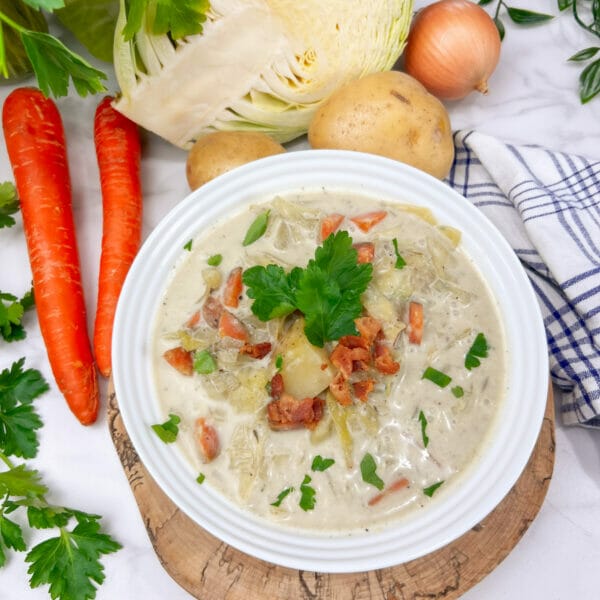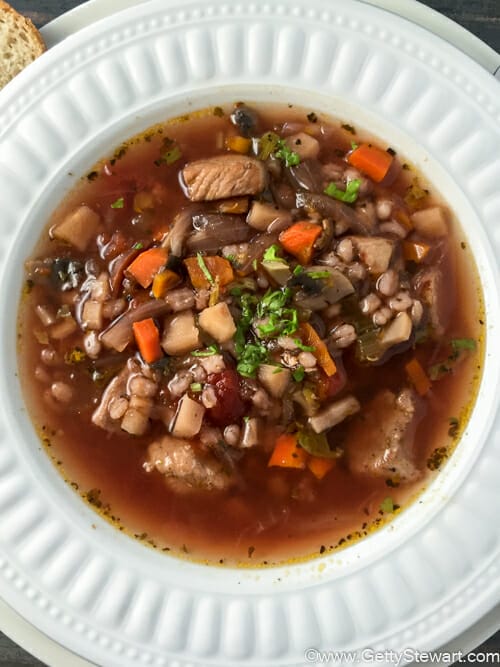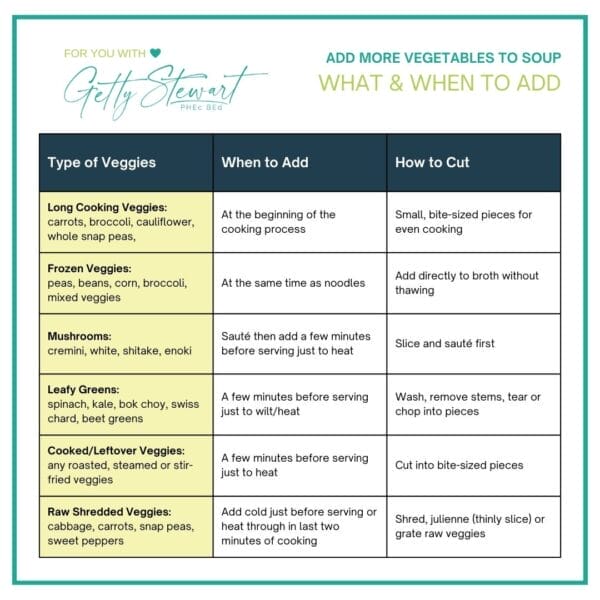Add More Veggies to Soup: 7 Simple Tips
Soups are an excellent way to load up on vegetables. Chances are that your soup recipe already includes some vegetables, but why not add more!? I’m a firm believer that there’s always room for more veggies.

What Veggies Can I Add to Soup?
Us home cooks have a bit of leeway, after all, we’re not trying to earn any Michelin stars, we’re just trying to eat well! That means, we have some wiggle room to add carrots to our broccoli soup and use leftover pizza sauce instead of canned tomatoes in our minestrone. This is real life, everyday cooking, so don’t get too stressed about the rules of what to add where. Trust your instincts.
My advice for what kind of veggies to add to what soup is to consider the overall flavor profile and theme of your soup and add veggies that fit within a particular theme.
The only veggies I would be cautious about adding are strongly flavored veggies like asparagus, Brussel sprouts, beets or fennel. They’re delicious, but they would overpower the overall theme of the soup that you’re making.
7 Ways to Add More Veggies to your Soup
You don’t need permission from your recipe to add MORE veggies to your next soup. But you don’t want a ‘clean out the fridge’ soup every time either. Here are some guidelines to help you add more vegetables to soup and keep the flavor, texture & theme you’re aiming for.
1. Start with Flavorful Aromatics
Sauté a mixture of aromatic vegetables like onions, garlic, and celery. Many soup recipes start with these, to add more veggies, include carrots, sweet or hot peppers, parsnips and mushrooms to the mix! Check out this Beef & Barley soup as an example.

2. Toss in Leafy Greens
Add leafy greens such as spinach, kale, or Swiss chard towards the end of the cooking process just until wilted to keep their vibrant green. Use fresh or frozen greens and cook them as little as possible to keep their bright color and to avoid a bitter taste. Try it in chowder or in this Italian Sausage & Kale Soup.

3. Pulse or Blend in Extra Vegetables
Add extra nutrients and a creamy texture by blending in veggies like carrots, potatoes, cauliflower, or bell peppers. Dinner guests won’t even notice that there’s extra veggies in their soup. Who would expect carrots, onions and potatoes in Broccoli Cheese Soup?!

4. Simply Add More of What’s Called For
Just add a quarter or half cup more of whatever veggies are called for in the recipe. Why not add an extra carrot and celery stalk to a pot of Mulligatawny or Borscht?

5. Add Tomatoes and/or Tomato Sauces
Include tomatoes, either fresh or canned, for a rich and savory base. Tomatoes add depth of flavor and partner well with a variety of other vegetables.
Don’t just stop at plain tomatoes – use a variety of tomato products to extend your flavor options. Side Note: This is an excellent way to use up whatever saucy tomato things you have open in the fridge.
- Tomato paste – adds depth of flavor and provides body to thin, brothy soup
- Salsa – adds a little extra zing to any soup that uses tomatoes
- Seasoned Tomato sauce – pizza sauce or pasta sauce is another way to add extra veggies and extra flavor

6. Add Frozen Vegetables
When you think there’s room for a few more veggies but don’t have a lot of time, toss in some frozen vegetables at the very end of the cooking process. Frozen peas, carrots, corn or beans heat up quickly and add great color and nutrients. For something a little more exotic try stir fry frozen veggies, they may take a little longer to heat through, but make a great addition. (Fun Fact: I used to add frozen peas to my kids soup bowls to help cool the soup for them – comment below if you’ve done that!)
Adding frozen veggies is also a great way to freshen up leftover soup that needs to be gussied up a little before it hits the table one more time!

7. Garnish with Fresh Vegetables
- Just before serving, garnish your soup with fresh, crisp vegetables.
- Try finely diced tomatoes or cucumbers lightly seasoned on cold soups, tomato soup, lentil soup or any spicy soup.
- Use grated carrots or finely julienned snap peas or sweet peppers on top of a bowl of Thai Curry Soup or Ramen Soup for added texture, crunch, color and interest.
More Veggie Soup Video Recipes & Tips
Click 👇🏼 to watch my full playlist of Soup Videos – including full recipes & quick flavor tips.
Select, store and serve seasonal food for everyday cooking with Getty. Getty is a food educator and Professional Home Economist, who loves sharing tips and recipes following the seasons from her Canadian kitchen. Sign up to get seasonal tips and recipes delivered to your inbox. Learn more about Getty or check out her books and pdf guides.



